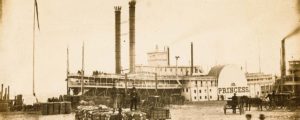The Great Exhibition, by John R. Davis, Published by Sutton Publishing, 260 Fifth Avenue, New York, New York 10001. 256 pages. $36 hardcover.
It is 1st May, 1851. More than 30,000 people have thronged into the Crystal Palace. Queen Victoria and Prince Albert arrive as if for the State Opening of Parliament, with nine coaches in the royal party. The air is filled with the strains of Handel’s Messiah from massed choirs and enormous pipe organs. The Great Exhibition has begun.
The Great Exhibition of 1851 was quite simply the first World’s Fair. There was nothing simple about it, however, as John Davis reports in his account of the event. While innumerable volumes have been produced on the Great Exhibition over the years, Davis’ ambition is to record an objective history of the mammoth undertaking in the context of its time. He succeeds very well indeed.
These were the days when Britannia ruled the waves. Victorian England was the richest, most industrialized, most powerful nation on earth. The blessings of mass manufacturing and a rapidly rising middle class fueled a spirit of liberalism and self-satisfaction. Social ills there may have been, but technology, determination, and good will were on the job. The Great Exhibition was a jubilant celebration of this Victorian optimism.
Ostensibly held to showcase the best of contemporary manufacturing and design, the event became a platform for promoting science, education, free trade, world peace, and a broad agenda of Victorian “modernism.” Davis clearly chronicles the motives which evolved and merged as the Great Exhibition grew from a dream of the Royal Society of Arts and Prince Albert into extravagant reality.
Staged on the south side of Hyde Park, the exhibition was housed in the awe-inspiring Crystal Palace. A superstructure of iron shrouded in 900,000 square feet of glass, the building itself was an oblation to progress. Some 63,000 visitors a day passed through the turnstiles to gaze at the marvels of the industrial age. National exhibits from the British Empire and around the world ranged from locomotives to stained glass, mining equipment to foodstuffs. Visitors wandered the broad aisles of the Palace past the Koh-I-Noor diamond, McCormick’s reaper, the Crystal Fountain, and an 18-ton lump of Welsh coal.
Davis is not content, however, merely to describe the Exhibition and its wonders. He explores its origins and its elaborate planning, the personalities and conflicting interests it involved, the music and literature it inspired, and the considerable impact it had on English society in the following decades.
By almost every measure the Great Exhibition was a huge success. For years after, Britons looked back to the event as the confirmation of their imperial role in the world. It had been the first event to promote Britain as a magnet for global tourism, and it made an enormous profit.
Today, the Albert Memorial stands placidly where the Crystal Palace once drew enthusiastic crowds. Across the street, the South Kensington complex includes the Albert Hall, the Victoria and Albert Museum, and the Natural History Museum–all inspired and funded by the Great Exhibition.
Dana Huntley




